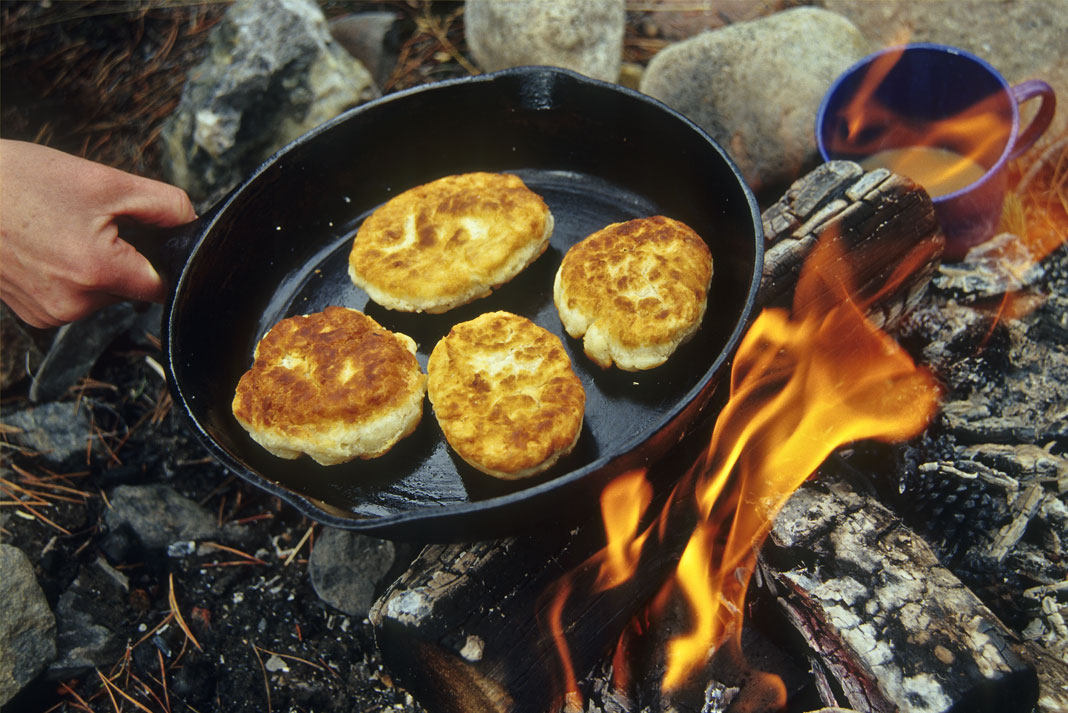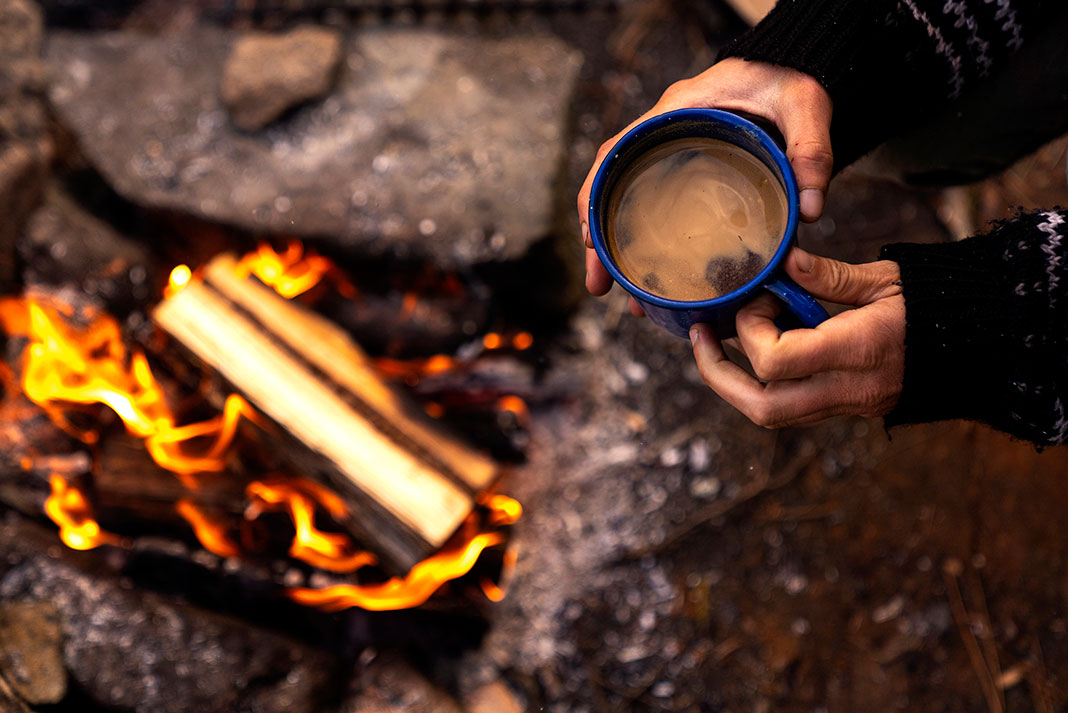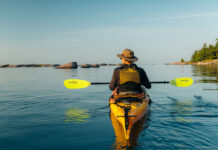People fall into one of two camps when it comes to cooking trip meals.

There are the pragmatists, always planning the next reconstitution of one of their many indistinguishable, vacuum-packed, dehydrated pouches. They are happy to tell you how heavy a meal is, but can get as brittle as a banana chip if you ask them how it tastes.
Then, there are the hedonists. They are easy to track by following the trail of steak juice leaking from packs bulging with heavy cans and jars.
Chris Nuttall-Smith is on a mission to blend the best of both approaches. He’s the right man for the job. The avid canoeist is the former food critic for Toronto Life magazine and the Globe and Mail newspaper. He’s also been the on-screen judge for Top Chef Canada, so you know he appreciates an entertaining approach, which comes through in his ambitious and attractive new cookbook, Cook It Wild.
Chris Nuttall-Smith’s instant camp-cooking classic: Cook It Wild
Foodies can be guilty of being a little too precious about food, and themselves. Nuttall-Smith’s down-to-earth approach is never guilty of the same anywhere in the advice and commentary sections, which make up almost a quarter of the book.
“I began to see simple, practical, high-reward hacks that could dramatically change the way we cooked and ate outside.”
Nuttall-Smith doesn’t want you to take food too seriously, but he does want you to eat seriously well without having to work too hard for it. His recipe? Prep ahead. The thrust of the book is to convince you that you can eat the way you want to, without carrying too much and without working endlessly over the campfire. Just be prepared to spend some time over the chopping block before you go.
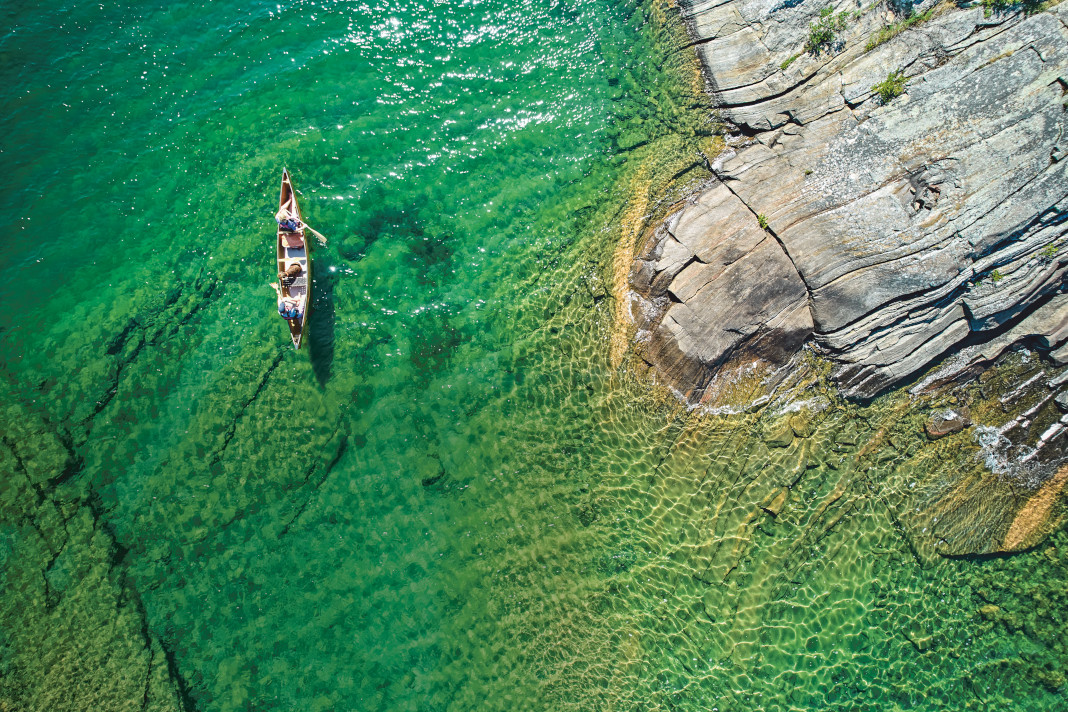
Before heading off on your trip, you’ll want to chop, cook, mix, seal and sometimes freeze ahead of time. Heed this advice, and you’ll soon find yourself pulling up to a campsite and unpacking a next course that needs minimal labor before it becomes a campsite meal to remember.
Nuttall-Smith explains his thinking in a conversational introduction. He had always tended to keep his campsite meals simple, to prioritize packability over delectability. This changed when a friend brought a block of frozen squid on a trip. It ended up being delicious.
“I began to see simple, practical, high-reward hacks that could dramatically change the way we cooked and ate outside,” Nuttall-Smith recollects. If it can be chopped, measured, mixed, marinated, braised, frozen or fully pre-made at home, suggests Nuttall-Smith, then do it, and reap the rewards while you enjoy restaurant-worthy meals at relaxed and tidy campsites. More than half the recipes come together in ten minutes or less at camp, yet most wouldn’t look out of place on a restaurant menu.
If you are old hat at cooking in the wild, you’ll be glad for an infusion of new ideas to put your practiced meal planning over the top.
If you are new to campfire cooking, Nuttall-Smith walks you through the basics, with sections on packing, equipment, planning, drinking water, stoves, cooking fires, food safety and what to do with the waste, though the beauty of Nuttall-Smith’s approach is that there won’t be much waste. You consolidated packaging before you left, and the food is so good there won’t be leftovers.
the top of every recipe indicates the ingredient weight, and tells you how long the provisions will last, whether kept cold or not.

Each of the more than 75 recipes has icons indicating if they are best cooked over a campfire or stove, or require a Dutch oven or cooler. Best of all, the top of every recipe indicates the ingredient weight and tells you how long the provisions will last, whether kept cold or not.
Nuttall-Smith believes it’s time that camp cooking caught up with how people actually want to eat. He’s put a lot of thought into blending ingredients that are as packable as they are palatable. It’s a very achievable goal. After all, as he notes, salted butter not only lasts longer than unsalted, it tastes better too.
To entice your appetite, Nuttall-Smith shares a collection of tips and even a sample recipe from Cook It Wild.
Camp cooking wisdom from the pages of Cook It Wild
Wheels of glory
Hard cheeses like Parmesan, Pecorino, Manchego and even aged cheddar can last for weeks in a pack (keep it shaded when possible). Once out of a vacuum pack, don’t stuff the cheese back in a plastic bag. Instead, wrap it in cotton cheesecloth and parchment paper or beeswax cloth (easy to make your own). This will keep it from getting sweaty or moldy.
Fresh foods that last
Even a week into a trip, you won’t regret finding any of the following at the bottom of a food pack: Granny Smith apples, beets, cabbage, carrots, ginger, onions or garlic. As well as fermented foods that just get better with age include sauerkraut and kimchi.
Chill
Coolers should be packed with a ratio of two parts frozen food or ice to one part perishables in sealed bags. Make your own ice blocks in empty juice cartons (or freeze the juice as treats for the kids). Fill remaining space with ice cubes and keep a towel underneath the lid to improve insulation. If chilling or freezing drinks for the first or second night, keep them in a separate soft cooler. You want to open the food cooler as rarely as possible.
Raid the condiment counter
For maximum flavor with minimum bulk, spend the off-season raiding the condiment counters at buffets and collecting take-out accessories. A few handfuls of ketchup, mustard, plum sauce, vinegar, mayonnaise, honey, syrup, relish and soy sauce packets will garnish a meal but travel effortlessly deep into a trip.
Libations
For cold beer on your first night, freeze tallboy cans (with at least 5 percent alcohol) for not more than seven hours in a freezer just before you leave. Wrap in newspaper (to become fire tinder). Later in the trip, use a mesh bag to deep-six alcohol to take advantage of the thermocline. Any lake deeper than 10 feet will be stratified and have a layer of distinctly colder water down deep. Or skip the need for chilling. Gin and vodka are best enjoyed cold, but whisky, rum, mezcal and tequila are just as good at campsite temperature.
Go Dutch
Consider adding an aluminum Dutch oven to open a world of baking desserts, and savory, one-pot meals like lasagna. When cooking with a Dutch oven, be sure to preheat the lid. Use three rocks to lift the base two inches off the ground, then cover a quarter of the ground underneath with hot coals and a third of the lid area. Rotate the pot a quarter turn every five minutes. Rotate the lid in the opposite direction, without lifting it off.
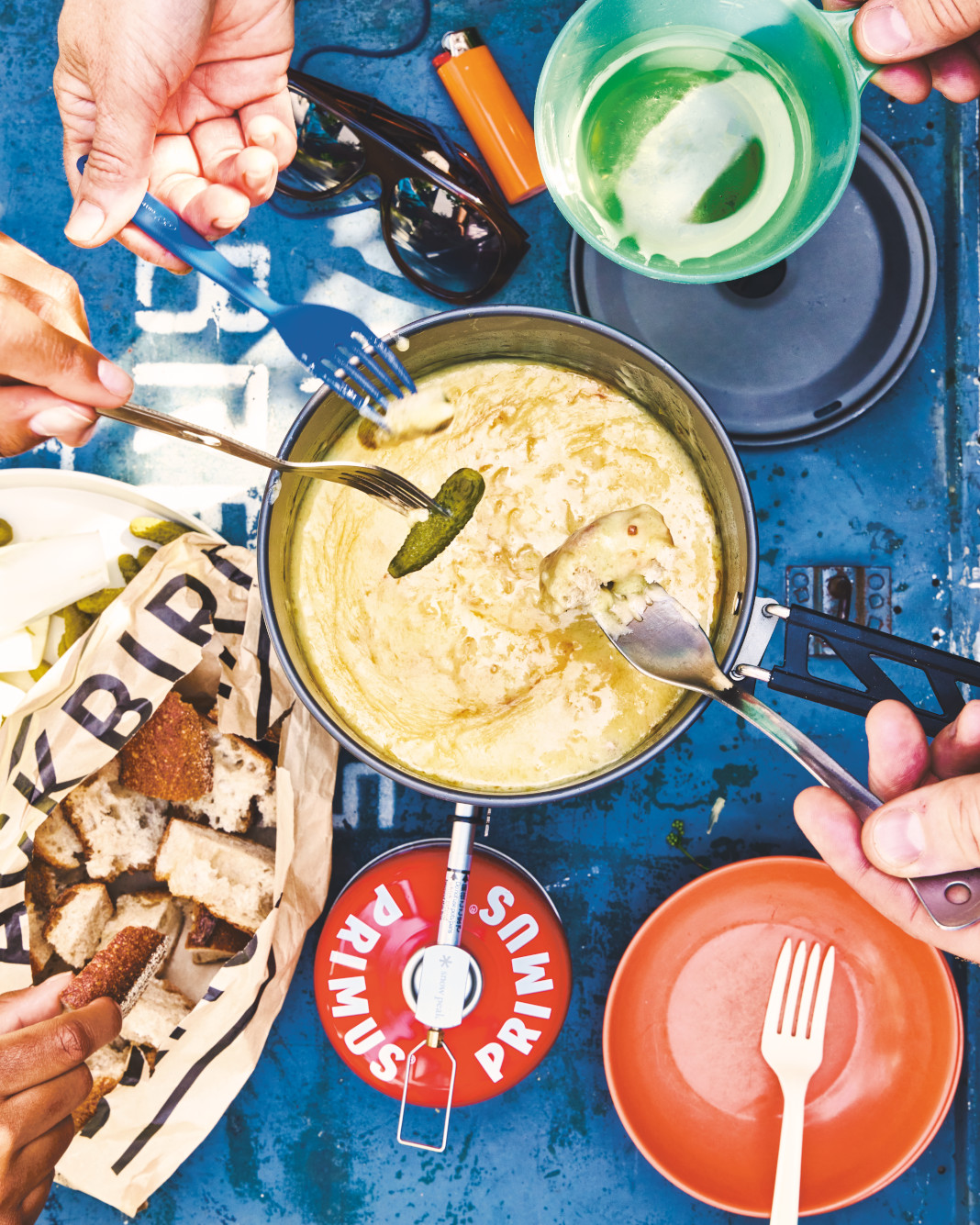
Sample recipe from Cook It Wild: Instant Caramelized Shallot-Cheese Fondue
This is exactly the dish you pull from your pack at 7,500 feet as a pre-winter storm blows past. It’s also exactly the dish you pull from your pack while car camping on a crisp fall day when everybody’s got rosy cheeks and ridiculous smiles, and they’re high on that whole outdoor life thing. Wherever you make it, this one-pot is drop-dead easy and crazy delicious, and it will make you a bona fide backcountry (or KOA-country) star.
Serves: 4
Ingredient weight: 2½ pounds
[cooler] [fire] [stove]
[backpack] [paddle] [car/rv]
At home
- 1 tablespoon salted butter
- 3 small shallots, thinly sliced
- ¼ teaspoon kosher salt
- 12 ounces Gruyère cheese, rind removed
- 1 tablespoon cornstarch
- Scant ⅛ teaspoon freshly grated nutmeg
At camp
- 1 cup dry white wine (thawed) [F]
- Prepared cheese and shallots (thawed) [F]
- 1 crusty baguette
- A few hardy, crunchy dippables such as endive leaves, or apple slices
1. Caramelize the shallots
In a small skillet over low heat, melt the butter. Add the shallots and salt and let them caramelize slowly and gently, stirring occasionally, until they’re tender, sweet-tasting, and an appealing hazelnut brown, 15 to 25 minutes.
Let the shallots cool, then wrap tightly in a small piece of parchment paper or wax paper.
2. Prep the cheese
Meanwhile, over a small bowl, grate the Gruyère on the coarse side of a box grater. Add the cornstarch and nutmeg and toss to combine thoroughly. Pack the cheese mixture into a resealable bag or airtight container, stick the packet of caramelized shallots inside the bag (on top of the cheese), seal the bag, and refrigerate or freeze. (The cheese mix and shallots will keep for one month, frozen.)
3. Melt, burble and serve
In a small saucepan over medium heat, bring the wine to a simmer. Add the cheese mixture and shallots. Decrease the heat to low and stir to melt the cheese. Once the cheese has melted and the fondue is bubbling gently, decrease the heat to its lowest setting.
Your goal is warm, very gently bubbling cheese. If your stove’s lowest setting has the cheese bubbling furiously, feel free to shuttle the pan on and off the burner.
Serve the fondue with sliced or torn bread and crunchy dippables, as well as forks if there are known double-dippers in your midst.
Keeps
Three days, unrefrigerated, or up to one week, kept cold.




